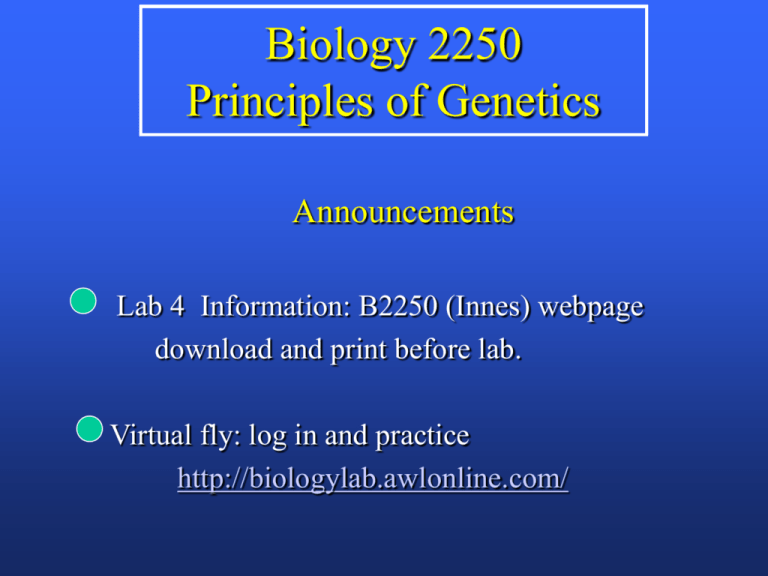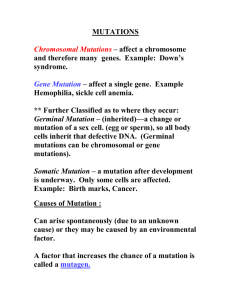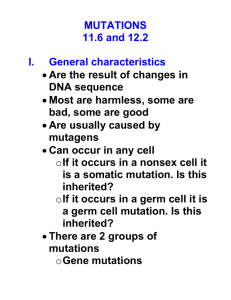Genetics --- introduction
advertisement

Biology 2250 Principles of Genetics Announcements Lab 4 Information: B2250 (Innes) webpage download and print before lab. Virtual fly: log in and practice http://biologylab.awlonline.com/ Test 2 Thursday Nov. 17 http://webct.mun.ca:8900/ All quizzes on WebCT for Review Office Hours: 1:30 – 2:30 Tue, Wed., Thr or by appointment: 737-4754, dinnes@mun.ca Mendelian Genetics Topics: -Transmission of DNA during cell division Mitosis and Meiosis - Segregation - Sex linkage (problem: how to get a white-eyed female) - Inheritance and probability - Independent Assortment - Mendelian genetics in humans - Linkage - Gene mapping -Gene mapping in other organisms (fungi, bacteria) - Extensions to Mendelian Genetics - Gene mutation - Chromosome mutation (- Quantitative and population genetics) B2900 Penetrance, expressivity and G X E PURPOSE: To provide a concise review for human cancer risk related to low-penetrance genes and their effects on environmental carcinogen exposure. CONCLUSION: Sporadic cancers are caused by geneenvironment interactions rather than a dominant effect by a specific gene or environmental exposure. Mutation Source of genetic variation: Gene Mutation (Phenotypic effects) - somatic, germinal Chromosome mutations (Ch. 11 prob. 1, 2) - structure - number Mutation Gene Mutation: a+------>a Forward mutation a ------>a+ Reverse mutation 1. Somatic mutation - not transmitted to progeny 2. Germinal Mutation - transmitted to next generation Somatic Mutations Petal colour: Rr red rr white Plant genotype: Rr mutation: Rr rr Somatic mutations Germinal mutations AA (blue) mutation Aa self aa(white) Mutant Phenotypes Morphological Lethal Biochemical Resistance Conditional - DTS (David T. Suzuki) (permissive and restrictive conditions) Mutation Frequency Drosophila eye-colour w+ w 4 x 10-5 per gamete Humans Hemophilia (X-linked recessive) 4 x 10-5 per gamete (1 in 25,000) “It is estimated that up to 30% of cases of hemophilia have no known family history. Many of these cases are the result of new mutations. This means that hemophilia can affect any family.” Mutation Frequency Drosophila eye-colour w+ w 4 x 10-5 per gamete Mutation rate for a particular gene: very low (efficient repair) but, Large number of genes in a genome: mutations occur every generation 4 x 10-5 x 50,000 genes = 2 mutations Gene Mutation Mutations are rare and random Ultimate source of genetic variation Cancer: Proto-oncogene oncogene cancer mutation “…in an oncogene mutation, the activity of the mutant oncoprotein has been uncoupled from its normal regulatory pathway, leading to its continuous unregulated expression.” tumor growth Chromosome Mutations Gene mutation: detected genetically Chromosome Mutations: detected genetically and cytologically 1. Structure 2. Number Chromosome Mutations 1. Structure Ch. 11 363 – 372 2. Number Ch. 11 p. 350 - 363 1. Chromosome Structure Karyotype: 1. size and number 2. centromere position: telocentric acrocentric metacentric submetacentric acentric (lost) Chromosome Structure 3. Heterochromatin pattern - heterochromatin (dark) - euchromatin (light) 4. Banding patterns: a) staining Giemsa bands b) polytene chromosomes (flies) G-bands Paint of Chr-22 “Paint” Structural Abnormalities Normal 1. Deletion a b c d e f a c d e f 2. Duplication a b b c d e f 3. Inversion c b f a e d 4. Translocation a b c d j k g h i e f Structural Abnormalities 1. Deletions: deletion homozygote---->usually lethal deletion heterozygote----> viable deletion loop (pairing of homologues) b a a c c d d deletion Deletion heterozygote deletion loop Pseudodominance Deletion Heterozygote: deletion loop (pairing of homologues) Phenotype: b a + c + d + deletion + b + + Deletion Mapping Prune pn Structural Abnormalities Deletion: notch-wing (Drosophila) Phenotype Genotype wing survival N+ N+ normal alive N+ N notch alive N N dead (recessive lethal) Genetics of Deletions • Reduced map distance ( chromosome shortened) • Recessive lethal • Deletion loop (detected during meiosis) Structural Abnormalities 2. Duplications: tandem duplication a b b c d maintain original function evolve new function Unequal crossing over deletion Tandem duplication Bar Eye Mutation (Dominant) Gene Duplication and Evolution Gene duplication - Evolution of new function Example: Hemoglobin genes - duplication Express in different stages: embryo – fetus – adult Hemoglobin: Alpha Beta Gamma ……….. Structural Abnormalities 3. Inversions - different gene order - usually viable abcdef abcdef homozygote NN abedcf abedcf abcdef abedcf heterozygote homozygote NI II normal (N) inversion (I) Cytological consequences of an Inversion Heterozygote: Inversion Loop Fig. 11-21 a b c d e a d c b e crossover X Inversion Loop Cytological consequences of an Inversion Heterozygote: Inversion Loop Cross-over within an inversion dicentric bridge (broken) acentric fragment (lost) deletions Inversion heterozygote with crossing over Fig. 11-22 Inversion Heterozygote • Reduced recombination frequency (suppression of crossing over) • Semisterile 4. Translocation a b c d j k g h i e f Translocation Heterozygote (meiosis) N1 N2 T1 T2 Translocation Translocation heterozygote Fig. 11-24 Translocation heterozygote Adjacent segregation T1 N2 N1 T2 inviable Translocation heterozygote Alternate segregation N1 N2 T1 T2 viable Translocation Change linkage relationships (position effects) Change chromosome size Semisterile - unbalanced meiotic products normal Corn Pollen aborted Structural Abnormalities Normal 1. Deletion a b c d e f a c d e f 2. Duplication a b b c d e f 3. Inversion c b f a e d 4. Translocation a b c d j k g h i e f Human Chromosomes Mutation Source of genetic variation: Gene Mutation - somatic, germinal Chromosome mutations (Ch. 11) - structure - number Chromosome Mutation (2. changes in number) Euploidy: variation in complete sets of chromosomes Aneuploidy: variation in parts of chromosome sets Euploidy 1x monoploid (1 set) = n 2x diploid (2 sets) = 2n 3x triploid 4x tetraploid 5x pentaploid polyploid (> 2 sets) 6x hexaploid n = # chromosomes in the gametes Polyploids Autopolyploids: within one species Allopolyploids: from different, closely related species Polyploids Larger than Diploids Polyploids Triploids: = 3n - problems with pairing during meiosis - unbalanced gametes - usually sterile Applications: seedless fruits, sterile fish aquaculture Formation of Triploids n = 3n n n Polar bodies n n = 3n 2n n Triploids (3x) Why can’t a triploid produce viable gametes ? Fig. 11-5 Triploids (3x) x=1 Gametes Triploids Gametes x=2 viable or Nonviable Triploids Probability (2x or x gamete) = 1 2 ( ) if x = 10 x-1 Prob. = 0.002 of viable gametes Autotetraploid Autotetraploid Doubling of chromosomes: 2x----> 4x Even number of chromosomes: normal meiosis 2<---->2 segregation------> functional gametes Origin of Wheat Fig. 11-10 Allopolyploid 2n = 14, n = x = 7 hybrid 2n = 28 Chromosome sets: n = 14 A, B, D 7 14 Triploid 7 7 7 2n = 42 x=7 n = 21 Polyploidy Plants: Animals: speciation - rare (sex determination) - fish (salmon) - parthenogenetic animals 123 11 22 12 12 Plant Polyploids % Polyploids 90 80 70 60 50 40 30 30 40 50 60 70 Latitute North 80 90 Chromosome Mutation (changes in number) Euploidy: variation in complete sets of chromosomes Aneuploidy: variation in parts of chromosome sets Aneuploidy Nullisomics (2n - 2) Monosomics (2n - 1) Trisomics (2n + 1) Aneuploidy Nullisomics (2n - 2) - lethal in diploids - tolerated in polyploids Monosomics (2n - 1) - disturbs chromosome balance - recessive lethals hemizygous Trisomics (2n + 1) - sex chromosomes vs autosomes - size of chromosome Aneuploidy Non-disjunction: Meiosis I Meiosis II Gametes n+1 n-1 n+1 n-1 n n x n - 1 ---------> 2n - 1 monosomic n x n + 1 ---------> 2n + 1 trisomic Aneuploidy Humans: (live births) Monosomics - XO Turner syndrome - no known autosomes Trisomics XXY Klinefelter sterile male XYY fertile male ( X or Y gametes) XXX sometimes normal 21 Down 18 Edwards syndromes 13 Patau G-bands 13 21 18 X Y Downs Births per 1000 Downs Births per 1000 25 20 15 10 5 0 20 25 30 35 40 45 Maternal Age (years) 50 Mutations Causing Death and Disease in Humans % of live births Gene mutations: 1.2 Chromosome mutations: 0.61 Chromosome Mutations (Humans) Trisomics XO Triploids Tetraploids Others Chromosome abnormalities % of spontaneous abortions 26 % 9% 9% 3% 3% 50 % Chromosome Mutations Comparison of euploidy with aneuploidy Aneuploids more abnormal than euploids: likely due to gene imbalance Plants more tolerant than animals to aneuploidy and polyploidy (animal sex determination) Summary Mutation Detecting - gene - chromosome (structure, number) - cytology genetic analysis - phenotype Rate of mutation - low Mutation - source of genetic variation - evolutionary change Chapter References Recombination, linkage maps Ch. 6 p. 148 – 165 Prob: 1-5, 7, 8, 10, 11, 14 Extensions to Mendelian Genetics Ch. 14 p. 459 – 473 Prob: 2, 3, 4, 5, 6, 7 Chromosome Mutations Ch. 11 p. 350 – 377 Prob: 1, 2 Mendelian Genetics Topics: -Transmission of DNA during cell division Mitosis and Meiosis - Segregation - Sex linkage (problem: how to get a white-eyed female) - Inheritance and probability - Independent Assortment - Mendelian genetics in humans - Linkage - Gene mapping -Gene mapping in other organisms (fungi, bacteria) - Extensions to Mendelian Genetics - Gene mutation - Chromosome mutation









